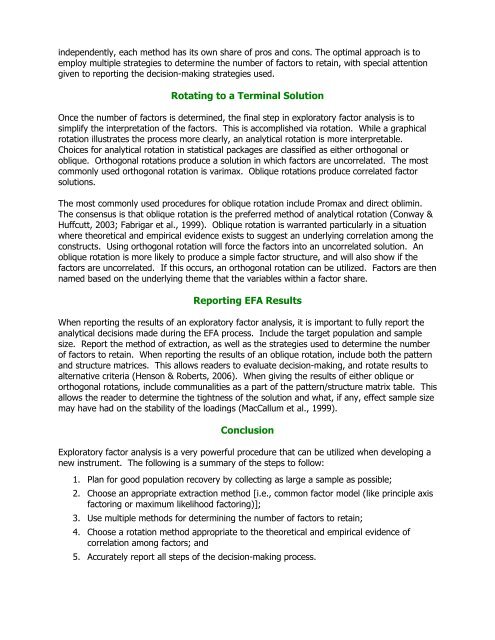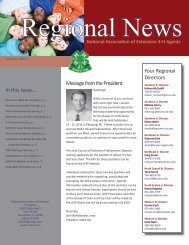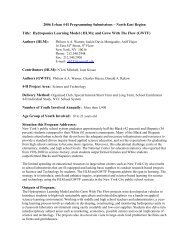Winter 2008 - Vol. 3 No. 3 - National Association of Extension 4-H ...
Winter 2008 - Vol. 3 No. 3 - National Association of Extension 4-H ...
Winter 2008 - Vol. 3 No. 3 - National Association of Extension 4-H ...
- No tags were found...
Create successful ePaper yourself
Turn your PDF publications into a flip-book with our unique Google optimized e-Paper software.
independently, each method has its own share <strong>of</strong> pros and cons. The optimal approach is toemploy multiple strategies to determine the number <strong>of</strong> factors to retain, with special attentiongiven to reporting the decision-making strategies used.Rotating to a Terminal SolutionOnce the number <strong>of</strong> factors is determined, the final step in exploratory factor analysis is tosimplify the interpretation <strong>of</strong> the factors. This is accomplished via rotation. While a graphicalrotation illustrates the process more clearly, an analytical rotation is more interpretable.Choices for analytical rotation in statistical packages are classified as either orthogonal oroblique. Orthogonal rotations produce a solution in which factors are uncorrelated. The mostcommonly used orthogonal rotation is varimax. Oblique rotations produce correlated factorsolutions.The most commonly used procedures for oblique rotation include Promax and direct oblimin.The consensus is that oblique rotation is the preferred method <strong>of</strong> analytical rotation (Conway &Huffcutt, 2003; Fabrigar et al., 1999). Oblique rotation is warranted particularly in a situationwhere theoretical and empirical evidence exists to suggest an underlying correlation among theconstructs. Using orthogonal rotation will force the factors into an uncorrelated solution. Anoblique rotation is more likely to produce a simple factor structure, and will also show if thefactors are uncorrelated. If this occurs, an orthogonal rotation can be utilized. Factors are thennamed based on the underlying theme that the variables within a factor share.Reporting EFA ResultsWhen reporting the results <strong>of</strong> an exploratory factor analysis, it is important to fully report theanalytical decisions made during the EFA process. Include the target population and samplesize. Report the method <strong>of</strong> extraction, as well as the strategies used to determine the number<strong>of</strong> factors to retain. When reporting the results <strong>of</strong> an oblique rotation, include both the patternand structure matrices. This allows readers to evaluate decision-making, and rotate results toalternative criteria (Henson & Roberts, 2006). When giving the results <strong>of</strong> either oblique ororthogonal rotations, include communalities as a part <strong>of</strong> the pattern/structure matrix table. Thisallows the reader to determine the tightness <strong>of</strong> the solution and what, if any, effect sample sizemay have had on the stability <strong>of</strong> the loadings (MacCallum et al., 1999).ConclusionExploratory factor analysis is a very powerful procedure that can be utilized when developing anew instrument. The following is a summary <strong>of</strong> the steps to follow:1. Plan for good population recovery by collecting as large a sample as possible;2. Choose an appropriate extraction method [i.e., common factor model (like principle axisfactoring or maximum likelihood factoring)];3. Use multiple methods for determining the number <strong>of</strong> factors to retain;4. Choose a rotation method appropriate to the theoretical and empirical evidence <strong>of</strong>correlation among factors; and5. Accurately report all steps <strong>of</strong> the decision-making process.






